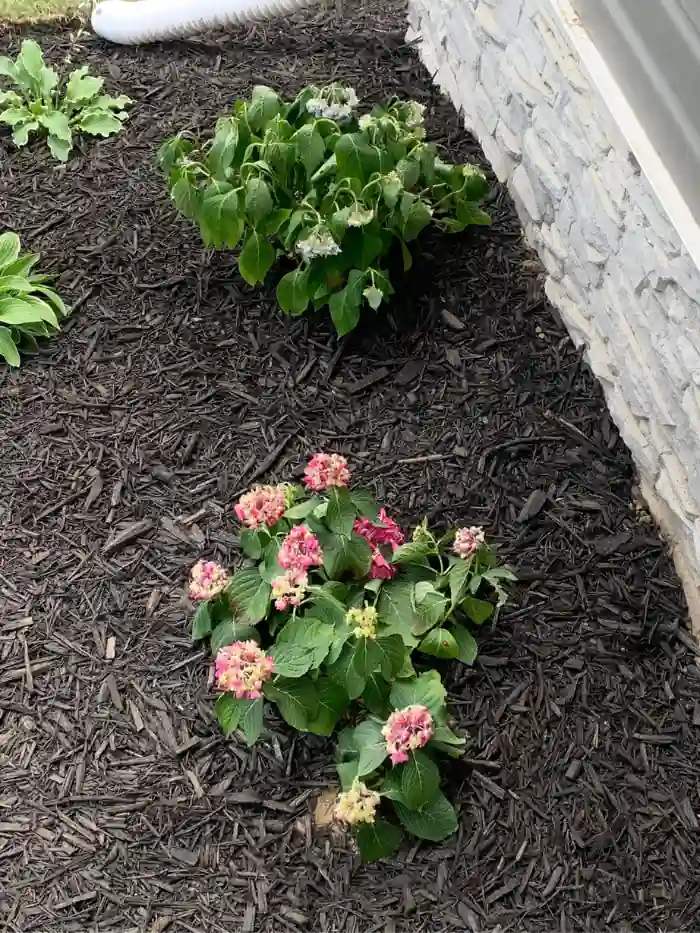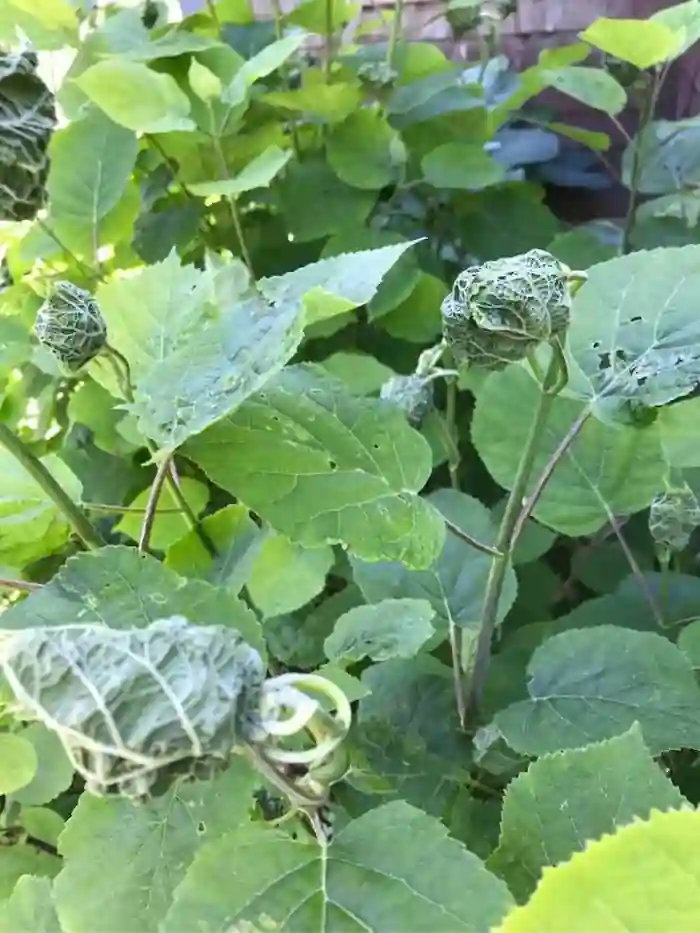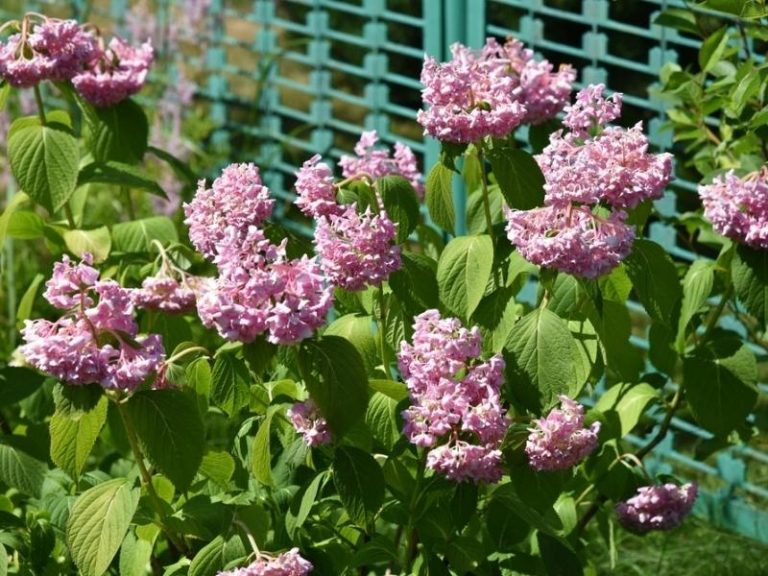Hydrangea Leaves Curling? Causes and Fixes that WORK
Curling and deforming hydrangea leaves signify the plant is stressed and needs immediate attention. The curled leaves make the plant unsightly and show that it is unhealthy. When leaves curl, you can expect stunted growth and an overall ill appearance.
The main reasons for curling hydrangea leaves are underwatering, overwatering, pest attacks, or scorching sunlight. The best solution is repotting the plant and placing it under shade to revive it. Water only when the when top 1/2-inch of the potting soil feels dry and feed it with a phosphorus-rich fertilizer.
My best advice is to examine the plant first to see the leaf curl type because that will tell you the real problem.
Types of leaf curl on hydrangea
- Leaves curling downwards– Hydrangea leaf tips wilt and bend toward the ground. Common causes include overwatering and phosphorus deficiency.
- Leaves curling upwards– Hydrangea leaf tips form an upward curve or curve towards the sky. Underwatered hydrangea leaves mostly curl upwards.
- Leaves curling inwards– Hydrangea tips move towards the leaf center. Pests and herbicide injuries cause this behavior.
What causes hydrangea leaves to curl?
Below, I’ve explained the main reasons for leaf curl in hydrangeas:
Overwatering
Hydrangeas thrive in well-draining, moist soils. However, overwatering make the soil soggy, which weakens the roots and makes them unable to absorb and transport water efficiently.
Meanwhile, hydrangeas need water for photosynthesis and transpiration. When the water doesn’t reach the leaves, they curl downwards to reduce the rate of water loss through transpiration.
Underwatering
The hydrangea soil must be well-watered and moist, so the plant thrives. But, underwatering makes the soil dry; thus, no water is absorbed and transported for physiological processes.
Consequently, underwatered hydrangeas curl their leaves to reduce the transpiration rate. Additionally, the leaves droop, wilt, curl, and turn yellow.
Learn more about yellowing leaves in hydrangeas.
Direct sunlight

Most hydrangea varieties prefer filtered or indirect sunlight. They love the direct morning sunlight but get scorched when exposed to the midday sun.
Direct sunlight burns hydrangea leaves, making them droop and curl at the edges and tips. In addition, the flowers get scorched, and the leaves feel crispy and drop off.
Learn more about drooping hydrangea leaves here.
Frost damage
After the hydrangea leaves unfold in spring, a sudden temperature drop can deform them, curl them in clumps, and turn them black. Frost freezes the plant cells and damages them.
Frost-damaged hydrangea’s new leaves wilt, turning black or brown and feeling crispy. They later wither and fall off the plant. Meanwhile, older leaves form black spots and curl too. The flowers also get damaged.
Transplant shock
Hydrangea leaves might curl or roll when newly transplanted to signify shock. If the leaf curl started soon after repotting your hydrangeas, the shock probably makes the leaves curl.
The plant’s roots don’t establish immediately after transplanting and thus cannot absorb water efficiently. As a result, it lacks enough water, thus showing shock signals such as leaf scorch, yellowing, curling, and wilting. Over time, the leaves turn brown.
Strong winds
Outdoor hydrangea leaves curl when winds blow across them. Strong winds blow away the air moisture around the hydrangea, increasing transpiration. Higher transpiration rates stress the plant causing droopy, curling foliage.
In addition, strong winds interrupt the transportation of water and nutrients in the plants, leading to curled leaves.
Pests

Aphids, scales, mites, and Japanese beetles are the most common pests on hydrangeas.
These pests have sharp mouthparts that pierce the outer cell tissues to suck the cell sap. Continual feeding on the leaves, stems, buds, and flowers deprives the plant of growth nutrients.
Insufficient nutrients lead to curling and browning of leaves. If the pests aren’t controlled, the hydrangea will grow slowly.
Diseases
Powdery mildew, leaf spot, and root rot can cause curling leaves. Fungi on the potting soil cause leaf spots and powdery mildew. Improper watering techniques invite fungi into the pot. Winds and pets can also carry fungi.
Poor drainage or overwatering can lead to root rot disease in hydrangeas.
Frost damage
A sudden temperature drop after the hydrangea leaves unfold in spring can cause leaves deformation, curling in clumps, and black spots. Frost freezes the plant cells and damages them.
A frost-damaged hydrangea’s new leaves wilt, turn black or brown and feel crispy. They later wither and fall off the plant. Meanwhile, older leaves form black spots and curl too. The flowers also get damaged.
Phosphorus deficiency
Insufficient phosphorus makes older hydrangea leaves deform, curl, drop prematurely, or appear smaller. Phosphorus deficiency is commonly caused by soil compaction and damaged roots that reduce uptake.
In plants, phosphorus promotes vigorous root and shoots growth. It also encourages energy transfer reactions that drive photosynthesis.
But when phosphorus is insufficient, the plant develops weaker roots that cannot absorb water and nutrients efficiently. Furthermore, phosphorus-deficient plants cannot photosynthesize normally. Therefore, they grow slowly, and their leaves curl, sag, deform, and drop prematurely.
The deficiency becomes visible in older leaves which deform and appear smaller.
How to stop hydrangea leaf curl
Here are the best fixes to revive a curling hydrangea plant:
1. Water the soil adequately
To fix curling leaves from underwatering, water the soil thoroughly. Check the soil moisture by dipping your finger or screw into the soil. Dry soils have no soil particles sticking on the finger or screw. Additionally, underwatered hydrangea pot feels light when lifted.
If the soil is dry, water it thoroughly until excess water overflows through the drainage holes underneath the pot.
Always water the hydrangea when the top half inch of soil is dry to keep the soil moist and to prevent the leaves from curling again.
2. Place the hydrangea under filtered sun
To protect the hydrangea from direct sunlight, place its pot near east, west, or south-facing windows.
3. Protect the plant from frost
Cover outdoor hydrangeas with a fabric cover when frost approaches
Removing affected leaves when frost occurs isn’t advisable, as illustrated by plant care experts at the University of California. Give the leaves more time, as some might recover after the frost.
Also, removing the affected leaves soon causes more damage to the remaining leaves in case another frost occurs because of less plant material to handle the frost.
After the frost clears later in spring, check your outdoor hydrangea to determine badly damaged leaves and cut them. Water the soil thoroughly to unfreeze it.
If there’s frost approaching in the coming months, cover your outdoor hydrangeas with garden fabric to prevent damage.
4. Apply a fungi-specific fungicide
Curling leaves from fungal diseases – powdery mildew and leaf spot – can be fixed by applying a fungi-specific fungicide.
Visit your nearest pest and disease control agent to advise you on the right fungicide.
5. Apply insecticidal soap or neem oil to kill pests
Remove aphids, spider mites, thrips, and slugs from hydrangea by spraying insecticidal soap or neem oil.
Neem oil kills insects by smothering them, while insecticidal soap destroys the soft-bodied insects’ cuticles. Add 1-3% concentrated neem oil to a spray pump, mix with water, and spray on the insects.
Reapply the neem oil after 5-7 days to remove any pests remaining.
6. Provide proper care after repotting
Transplant shock occurs when the plant struggles to adapt to new environmental and soil conditions.
Be more gentle to minimize the shock. First, buy a hydrangea with numerous deep roots to increase its functionality in a new environment.
After transplanting, water the plant thoroughly to keep the soil moist. Water when the top half inch of soil is dry and place the hydrangea under filtered sun. Often mist potted hydrangea to maintain optimum humidity.
Here are important hydrangea care requirements:
| Parameter | Requirement |
| Water | Upto 3 times per week to keep the soil moist |
| Sunlight | Partial sunlight |
| Soil type | Well-draining, humus-rich soil |
| Soil pH | 6.0 to 6.2 |
| Fertilizer | Feed them in March, May, and June |
7. Test the soil and apply all-purpose fertilizer
Fix phosphorus deficiency by acidifying the soil and applying phosphorus-rich fertilizer.
Test the soil using a soil pH kit to determine its pH. You can also take soil samples to the nearest university extension lab for testing. Hydrangea thrives in pH 6.0-6.2. Beyond 6.5, phosphorus deficiency kicks in.
Apply compost or organic matter to acidify too alkaline soils.
Add multipurpose fertilizers for soils with less phosphorus. Ideal phosphorus-rich fertilizers are those with NPK ratios 10-10-10, 8-8-8. Alternatively, add phosphorus-rich organic matter such as fish meal, bone meal, cottonseed meal, blood meal, and compost.
8. Repot the plant
A hydrangea with overly moist or soggy soils can potentially cause root rot diseases, which makes the leaves curl and turn yellow. To treat root rot, repot the plant.
Here’s how to treat root rot and repot your hydrangea:
- Gently remove the plant from the container. Hold the base of the stem near the soil and turn the pot upside down so the plant falls on your hands.
- Wash off all soil around the roots with running water.
- Cut off all damaged roots that are too weak, soft, or brown using scissors.
- Sterilize the scissors in rubbing alcohol to kill any fungus.
- Dispose of the old potting soil and clean the pot thoroughly with bleach or vinegar to kill and remove the fungus. Dry the pot.
- Add new potting soil to the pot.
- Replant your hydrangea by placing it inside the planter with potting soil and adding more soil to firm the plant.
- Water the plant lightly with water and place it under filtered sun.
Prevention
After treating the curling leaves, provide optimum environmental conditions that promote healthy hydrangea growth to prevent curling in the future. Here are the best ways to control hydrangea curling leaves.
- Place the hydrangea under filtered sun.
- If indoors, move the plant away from air vents and fireplaces to prevent high temperatures that retard growth.
- Water the plant often when the top half inch of soil is dry to maintain moist soil.
- Rub the plant often with peppermint or lavender oil to keep pests and insects away.
- Water the hydrangea directly on the soil, not the leaves, to avoid fungal infections.
- Use well-draining soil with pH 6.0 to 6.2 to ensure the soil has all the necessary growth nutrients.
- Fertilize the hydrangea two to three times when it’s actively growing from March through September.
- Bring your potted hydrangeas indoors when a frost is approaching to avoid frost damage. In addition, cover the ones in the garden with a row cover.
- Mist the plant regularly to remove dust that attracts some pests.
- Add a humidifier to rooms with low humidity below 50%.
Conclusion
Hydrangeas curl their leaves to signify stress. If you notice curling leaves, check the humidity, soil conditions, temperature, sunlight exposure, and presence of pests or diseases to identify the cause.
Depending on the reason, use the ideal solution as guided by this article to treat your plant. Remember to salvage your hydrangea fast, as uncontrolled curling leaves can lead to stunted growth and plant death.
To prevent curling hydrangea leaves in the future, provide optimal growth conditions to promote healthy growth.
References
- The University of California Agriculture and Natural Resources: Managing Pest in Gardens.
- Iowa State University: Phosphorus Basics.



